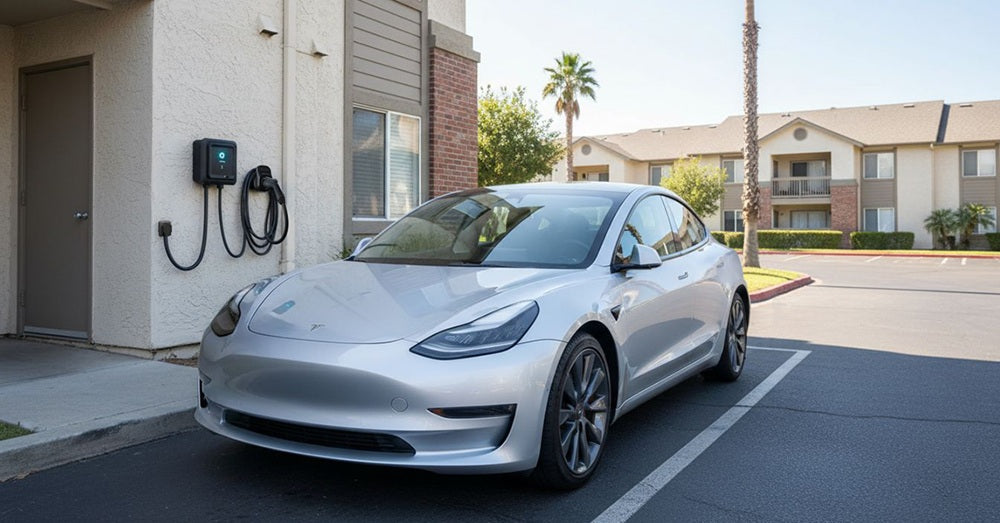Learn how to charge your electric car at home without a garage. Explore outdoor EV charging setups, safety tips, and affordable installation options.
The Challenge of Charging Without a Garage
Imagine, you live in an apartment complex. Or maybe you rely on street parking. Or you simply park in a driveway without access to private parking. Since more and more drivers tend to make the switch to electric cars and all of them have different lifestyles, budgets and preferences, it’s only natural for the important question to come up: what are EV home charging options, if I don’t own a garage?
Good news for everyone who lives in homes without enclosed parking spaces – you can still not only manage your charging effortlessly, but even enjoy having your EV without sacrificing your convenience. In this article we will cover the topic of how to charge your electric car at home without a garage and what are the best electric car charging solutions for apartments.
Can You Charge an EV Without a Garage?
Yes – without a doubt. You can charge your EV at home safely, as long as you use the right equipment and follow a basic installation instruction.
There are two types of charging setups: indoor and outdoor. How does the outdoor charging setup differ from the indoor one? First of all, weather exposure. Your outdoor EV charger needs a level of protection against any conditions – a weather-rated charger (typically IP65 or NEMA 3R). Standard indoor chargers expose you to a certain amount of risk if not chosen properly, that’s why your main focus has to be on getting specifically a weather-rated charger.
Secondly, you have to take into account the cable length and its protection. If you choose a standard cable – you would, without a doubt, need an extension cable for your outdoor charging setup. And the thing with such extensions is that they cause a major risk for your EV’s safety since they can’t endure prolonged charging periods without failure. But the good news is that certain companies create charging setups with the maximum cable length that is allowed which would help you both in logistics and safety. As permitted by the National Electric Code (NEC), the longest output cable you can have is 25 feet and this is the length you should aim at when choosing your charging provider.
With the right equipment, your outdoor charging setup will work as efficiently as any garage, if not better. And once you found a reliable EV charger for your driveway, you can use a couple of tips on the outdoor EV charger installation.
Best Options for Home EV Charging Without a Garage
1. Install an outdoor-rated wall charger.
For those who have an exterior wall near your driveway – a wall-mounted EV charger is one of your most convenient options. You can mount it on a wall or fence or any similar surface that is available near your parking spot. Don’t forget to choose a charger with a holster to keep your cable off the ground and avoid any possible damage.
2. Use a driveway or carport setup.
Okay, and what if you park your car under a carport or right in the open driveway? You can still effortlessly EV charger for the driveway. Just mount your EV charger to any external wall of your parking place and charge your EV every time you return home. Many EV owners also go for an additional protection with a small roof above the mounted charger to shield it from weather exposure but you won’t need it if your EV charger already has its inner shielding mechanism provided.
3. Smart portable chargers.
If you either rent an apartment or travel a lot – a flexible solution would be a portable EV charger that plugs into a 240V outlet. Portable chargers are convenient, safe, easy to store and you can use them both at home and on your trips.
4. Shared community charging solutions.
If you face any limitations while trying to set up home EV charging without a garage – don’t worry; there are still some options available. For example, if you live in a multi-unit apartment complex, you might not be able to install your own charger. But you can address your property management, homeowners associations or any other local programs that assist and support shared charging setups in parking spaces. So, try contacting your landlord to help you come up with installation options or shared charging costs.
How to Install an Outdoor EV Charger Safely
If you are having your first EV charger and you don’t feel confident with the placement where you mount the charger, or the safe way of mounting your charger, or any other setup aspects – don’t hesitate to hire a certified electrician. From the long-term perspective, investment in safety from the first step will save you a lot of money in the future.
Here is what you have to consider when installing your outdoor EV charger:
- Weather-proof equipment: use only weather-proof conduits, outdoor-rated setup and pay extra attention to the sealed enclosures in your charger design. You might need to spend more on a better-designed charger but later it will save you from all the trouble with power surges and short circuits.
- Distance from the breaker panel: you want to choose as short a distance between the electric panel and charger as possible to minimize voltage drop. This might give you some limitations in your apartment complex so don’t hesitate to reach out to your electrician and landlord to come up with the best solution.
- Pay attention to grounding: proper grounding will keep your entire charging system safe, preventing electrical shocks and voltage surges.
Charging via a Standard Outlet (Level 1) vs. Dedicated Charger (Level 2)

Most first-time EV owners choose Level 1 charger and logically so. While Level 1 charger is indeed the common charger that can be used with your standard home outlet, here is why it might be better and safer for you to go straight for Level 2 charging.
Speed: on average, dedicated Level 2 chargers work 3-7 times faster and that’s the speed you’d like to use, not having a garage or other indoor spaces for charging.
Weather-proofness: Level 2 chargers also provide more stable charging at any weather conditions, giving you safety without jeopardizing the speed.
Safety: for outdoor EV charger installation, Level 1 chargers lack the necessary shielding from power surges and short circuits and that’s why going for Level 2 charger would be safer for your driveway charging setup.
Design: maybe the design of your charger is not your first priority, but compact space-saving design for your outdoor setup should be, considering the possible lack of space in your driveway, and that’s why you’d want to choose a Level 2 charger.
Managing Weather Conditions and Safety Concerns
The common misconception preventing people without garages from buying their EVs is that the outdoor charging isn’t safe and reliable. We already established that this is not true at all and with the right equipment you can indeed create a safe setup, but how exactly do you manage the weather conditions and address the safety concerns? Here is some advice that will help you with your outdoor charger installation:
- Protect your cables and connectors from rain and snow. Use additional protective shielding if necessary or, if you’d like to avoid additional bothers, simply choose a charger provider that has a built-in shielding system.
- Use GFCI outlets and weatherproof enclosures. This advice is quite logical but many EV owners often underestimate the importance of having a reliable safety system so note this advice as your best electric car charging solution for apartments.
- Avoid using extension cords. They are simply not built to withstand prolonged periods of charging and may overheat. Choose reliable brands that offer long certified cables within their charging setup.
Wall-mounted EV chargers such as EVIQO chargers have water-resistant housing and a built-in safety system. Additionally, EVIQO chargers offer extra long 25-feet cables that will allow you to charge your EV with ease, without exposing your car to any potential damage.
Costs of Installing Outdoor EV Charging at Home
The installation costs depend on several things:
- Distance from electrical panel to installation spot
- The type of wiring and power supply in your apartment complex
- The EV charger model you choose
On average, the installation of a wall-mounted Level 2 EV charger costs from $300 to $1000. Keep in mind that this is the one-time investment that will help you to charge your car safer, better and faster. If you do your setup correctly from the beginning, you won’t need any additional investments for many years to come.
Moreover, EVIQO offers 3-year warranty for the EV chargers so this way you can secure your nearest charging future.
EVIQO also provides discounts and rebates of different kinds. To see if you are qualified for any rebates, you can visit here.
Conclusion: Charging Without a Garage Is Easier Than You Think
Having a garage is not only necessary for charging your EV, but you can also create an even better charging setup for your car than some indoor setups. Modern chargers work outdoors perfectly, not only with additional protective shielding, but there are also charging companies at the market that provide extremely safe and space-efficient chargers for your home and apartment and that’s all you need to charge your EV at home safely without a garage.
Don’t forget the three key components for creating a convenient and safe setup: provide high-quality installation, choose a reliable charger, and follow basic safety rules. And if you have any questions or concerns regarding your outdoor installation – don’t hesitate to reach out.





Leave a comment
This site is protected by hCaptcha and the hCaptcha Privacy Policy and Terms of Service apply.